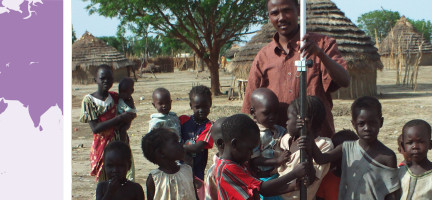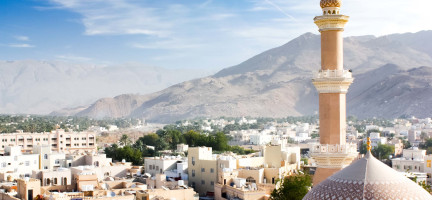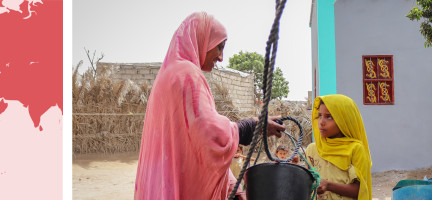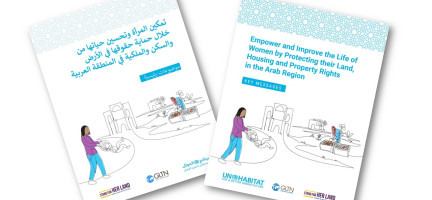Oman
The Sultanate of Oman, located on the south-eastern coast of the Arabian Peninsula, borders the United Arab Emirates, Saudi Arabia and Yemen. The country is 309,500 sq km in size, with a 2,092 km long coastline, and rugged mountains in the north and south. A vast gravel desert plain covers most of the country, which experiences sandstorms and dust storms in summer, and periodic droughts, with average precipitation of 125 mm per year.
Oman has experienced exponential population growth since the early 2000s, climbing from 550,000 inhabitants in 1960 to over 4.6 million in 2023 [1]. With 87 per cent of Omanis living in urban areas, compared to roughly 15 per cent in 1960 [2], the country shares the urbanization patterns of other countries in West Asia. Oman’s population is concentrated in urban centres along its coast, including its capital city Muscat, which exposes it to vulnerabilities related to sea level rise.
Oman is considered a high-income country, with an economy centred mainly around the oil industry. The discovery of oil in commercial amounts in the 1960s significantly impacted the country’s economy and shaped its land sector, as most of Oman’s land is currently under usufruct use concessions to oil and gas companies.
This page presents a snapshot of Oman’s land sector. Much of its content was extracted from the report Oman Land Sector Assessment, prepared by the Urban Training and Studies Institute and the Arab Land Initiative of the Global Land Tool Network [3].
Legal and Institutional Framework
The legal and institutional framework governing land tenure and management in Oman, comprising public and private stakeholders, is intended to facilitate the fulfilment of Oman’s vision and objectives as outlined in the Oman Vision 2040, the Tenth Five Year Development Plan 2021-2025 and the Oman National Spatial Strategy for guiding urban growth. Land tenure arrangements and real estate development are regulated by laws issued by royal decree.
The Oman Vision 2040[4] is the country’s long-term development framework launched in 2021. It is comprised of 12 National Priorities and related Strategic Directions. The Vision’s tenth priority, Development of Governorates and Sustainable Cities, addresses urbanization and land issues in Oman, and identifies the government’s strategic direction as comprehensive geographic development through decentralisation and the development of limited urban hubs, and the sustainable use of lands.
The Tenth Five Year Development Plan 2021-2025 [5] is Oman’s medium-term action plan, and the first five-year plan that aligns with the Oman Vision 2040. Under the Economy and Development pillar, the plan lists “developing sustainable governorates and cities” as one of its key objectives.
The Oman National Spatial Strategy 2040 [6] is intended to guide urban growth and rural development, aligning with the Oman Vision 2040. It elaborates regional strategies for all eleven governorates and includes proposals for a legal planning framework, a new planning information system, and capacity building interventions. The strategy also addresses socio-economic questions around effective integration of infrastructure, better protection of vulnerable areas and dealing with climate change and the post-oil era.
Article 11 ofOman’s 1996 Constitution (with Amendments through 2011) [7] safeguards the private ownership and transfer of property. All natural wealth and resources, however, are the property of the State, with concessions or investments granted only by law for a limited time and in a way that preserves national interests. General confiscation of property is prohibited, though the state reserves the right to expropriate property for the public interest in cases stipulated by the Law, as long as the dispossessed person is fairly compensated. The Constitution stipulates that Inheritance is a right governed by Islamic Shari’a law.
Land Law 5/80 [8] regulates individual and corporate land ownership in Oman, guarantying lands rights to the Omani population, differentiating between Omani, non-Omani from Gulf Cooperation Council countries (GCC) and foreign ownership. Corporate ownership of real estate is restricted under Omani law, though can enjoy usufruct rights according to Usufruct Law 5/81 [9] and its amendments contained in Law 59/2022 [10]. In an effort to promote tourism in Oman, the law of Integrated Tourism Complexes 12/2006 [11] allows non-Omanis to own real estate in areas designated “integrated tourism complexes”.
Conditions for distribution of government lands to Omani citizens, including land ownership rules and land use rights, as well as conditions for granting residential lands, commercial and industrial lands, and agricultural lands, are contained in the Government Land Entitlement Law 42/2021 [12]. This replaces the recently repealed Law 81/1984 [13]. and was issued in accordance with Oman’s institutional and organizational reform in line with Oman Vision 2040. Article II of the new law states that land allocated for commercial, industrial, and agricultural purposes will follow the rules and regulations of the Usufruct Law 5/81 and its amendments in Law 59/2022, while land allocated for housing purposes is governed by the new rules and regulations contained in an annex to Law 42/2021. Law 84/2020 [14] Governing the Use of Agricultural Land was suspended via Ministerial Decision 95/2023 [15].
Land tenure
Oman’s legal tradition is largely based on Shari’a law, which also influences the land sector. Laws are issued through Royal Decree, as the Sultan holds ultimate decision-making power on matters of land tenure. The Sultan also exercises the right to bestow state land at will, which is common among the Sultans on the Arabian Peninsula and the King of Saudi Arabia [16].
Two main types of land tenures can be distinguished in Oman: state land and privately owned land. Only Omani nationals are traditionally entitled to own land privately. A new exception to this is the 2006 law which allows foreign ownership and investment in residential and related real estate within specific areas designated by the Ministry of Tourism, with the purpose of supporting Oman’s burgeoning tourism industry.
Population growth, rapid urbanization and oil discoveries in the second half of the 20th century increased the demand for land and housing. To respond to this pressure on land, especially in urban areas along the coast, the Sultanate established a land lottery to allocate government land to Omani citizens in the 1980s. The allocation system is intended to be equal and inclusive, promising plots of land for all Omanis aged 23 and above who are sole supporters of their family, or individuals above the age of 40 if they do not have a family. Applicants are only granted land in their own state, or in the state where their permanent workplace is located. The land lottery has at times been criticized for alleged untransparent procedures and its encouragement of unsustainable low density urban development, leading to a car-based society.
Usufruct laws enable companies to exploit and use land for specific purposes with an obligation to return it upon the termination or expiry of the usufruct agreement. In Oman, all commercial, residential-commercial, industrial and agricultural government-owned land is governed by usufruct laws. This allows non-Omani companies to use the land in question for a specified time according to a project’s needs, and not exceeding 99 years. When the usufruct rights expire, they can be renewed upon agreement, otherwise all rights revert to the grantor (owner), who must compensate the grantee the value of any additions to the land. Usufruct rights to state-owned lands are granted through auction by the Minister of Housing and Urban Planning. Individual Omani citizens may also own commercial, industrial or agricultural land, and may lease to non-Omanis under similar conditions, though they are prohibited from selling the land to non-Omanis.
Land value
Land and property in both rural and urban areas in Oman is not subject to tax. Municipal taxes apply to various services including property rents (3 per cent), hotel occupancy (5 per cent) and leisure and cinema houses (10 per cent). A stamp duty of 3 per cent is applicable to the registration and transfer of land and property.
Land and property valuation is a responsibility of the central government and supervised by the Ministry of Housing and Urban Planning. While land valuation professionals are officially recognized and registered in Oman, their services are not available to all, there is no government information system that records land value. Property developers are able to undertake valuation activities under the supervision of the Ministry.
Residential land prices however, particularly in the Muscat Governorate where the capital is located, have risen in recent years, with an increase of 14.8 per cent recorded in the second quarter of 2023 [17].
Land use
Urban areas in Oman account for approximately 5,651 sq km of land use, just 2 per cent of the country’s total land area [18]. More than 50 per cent of the population in Oman are concentrated in Muscat and Al-Batinah coastal plain. The populated coastal areas of Oman are exposed to the risks of climate change, especially the effects of Sea Level Rise (SLR). Erosion along the coastal line is another major challenge, especially in Al-Batinah, where the coast retreats at a rate of approximately 60 cm per year. Successive cyclones in the 2000s and 2010s put the Omani population under further environmental stress.
Agricultural use in Oman accounts for only 14,701 sq km, less than five percent of land in the country, most of which is permanent pastureland [19], though 22,000 sq km, or seven per cent of land in Oman, is considered arable [20]. According to the Ministry of Agriculture, Fisheries and Water Resources. cultivated land increased from 720 sq km in 2000 to 1,089 sq km in 2018 [20]. Most of Oman’s agricultural land is concentrated on the Al-Batinah coastal plain.Allocation of agricultural land is managed by the Ministry of Housing, which prescribes land use including agricultural purposes. The contribution of agriculture to the national GDP has declined significantly since the 1960s, falling from 74.2 per cent in 1961 to just 1.8 per cent in 2022 [21].
Oil and gas is the biggest industry and primary contributor to Oman’s economy. According to the Ministry of Energy and Minerals, the vast majority of land in Oman is currently allocated to a number of petroleum companies under oil and gas concessions (or usufruct use) [22]. As of 2022 there are 380 oil fields in Oman which collectively produce over one billion barrels of oil per day, and almost five billion standard cubic feet of natural gas per day [23].
Forests account for only 31 sq km of land in Oman. In January 2020, the Environmental Authority (formerly the Ministry of Environment and Climate Affairs) launched the National Initiative for Plantation of 10 Million Trees [24] or “Ashjar initiative”, a nationwide project to plant ten million trees across Oman in order to combat desertification and land degradation, and to preserve wild plant species. As of 2019, 18,100 sq km or 5.89 per cent of land in Oman is considered degraded, while 134,600 sq km or 43.65 per cent of land is under drought conditions [25].
Land development
The Oman National Spatial Strategy 2040 (ONSS) [6] is a comprehensive spatial framework for directing, organizing, and implementing sustainable high quality urban and rural development in Oman until 2040. Its objective is to enhance socio-economic prosperity while safeguarding the environment for future generations, while providing guidance for regional and local structural plans as well as the consecutive five-year national development plans. In short, it is set to be a new solid framework for a national and regional land development strategy that will ensure a more balanced sustainable socio-economic and spatial development in the Sultanate.
Planning activities in Oman are conducted in all regions and provinces based on structural plans (to determine land use in cities and villages), detailed plans (detailed components of towns and villages) and studies. There are a number of mechanisms to control land subdivisions, manage consolidation in urban and rural areas and change land use through planning permissions and building permits, which will be further developed under the ONSS. These mechanisms, which are regularly enforced, ensure that construction is aligned with land use regulations. The property development process is considered easy for landowners and the public authorities.
Land development is also closely linked to and dependent on the lottery system that allocates plots of government land. According to some, this lottery system is not transparent and encourages parallel land markets and land speculation at the expense of lower income households for whom the access to ownership is more difficult. Moreover, landowners’ capacity to develop their land depend both on their financial capabilities and the level of governmental infrastructure provision in their area. According to the Ministry of Housing and Urban Planning, 40 per cent of land in the city of Muscat is undeveloped; only 19 per cent of Muscat landowners and 7 percent of landowners outside of the city have developed their allocated plots [26].
By law, the state reserves the right to expropriate private land for public development, but generally avoids doing so due to high cost of compensation and the need to avoid conflicts.
Land dispute resolution
Oman has a well-structured formal system to resolve conflicts and disputes related to land rights and parcel boundaries. However, the process can be slow, at times is not sufficiently affordable and the procedures to access it are not well publicised. The proportion of land-related cases in the formal courts and non-formal disputes resolution mechanisms is not known. Some land-related tensions have occurred in border regions, leading to the suspension in 2018 of land ownership for non-Omanis in those areas.
Women and land
According to Article 1 of Law 81/1984, since the establishment of the Government Land Entitlement System women have been eligible to own a plot of land through the allocation lottery, so long as she is the sole supporter of herself or her family. This differed from the eligibility of men, who became eligible at age 21 regardless of whether or not he was the sole supporter of his family. The allocation system was amended by Law 125/2008 [27], which stated that both and men had equal right to own land at age 23, or younger provided they were the sole supporter of their family. When the land allocation system was overhauled in 2021 through Law 42/2021, additional amendments for women to own land were included: both women and men became eligible to own land at age 23 only if they were sole supporter of their family; in cases where a man is the sole supporter of the family, his spouse is also included on the land title deed; women married to a non-Omani man and permanently residing in Oman also became eligible, as did divorced, widowed, abandoned, and childless women; both women and men who only support her- or himself became eligible to receive land at the age of 40.
Inheritance of land is still governed by Shari’a law under Oman’s Personal Status Law. While women have a right to inheritance, in many cases they receive less than men. In the case of a parent’s death, daughters receive half the share of sons [28].
References
[1] UN World Population Prospects, UN Department of Economic and Social Affairs, Population Division
[2] UN World Urbanization Prospects, UN Department of Economic and Social Affairs, Population Division
[3] El-Megharbel, Nihal and Shaharin Annisa (2021). Oman Land Sector Assessment: Background Paper
[4] Sultanate of Oman Ministry of Economy (2019). Oman Vision 2040
[5] Sultanate of Oman Ministry of Economy (2020). Tenth Five Year Development Plan 2021-2025
[6] Sultanate of Oman Ministry of Housing and Urban Planning (2021). Oman National Spatial Strategy 2040
[7] Sultanate of Oman 1996 Constitution with Amendments through 2011
[8] Sultanate of Oman Royal Decree 5/80 Promulgating the Land Law of 1980
[12] Sultanate of Oman Royal Decree 42/2021 on Granting Government Land
[13] Sultanate of Oman Royal Decree 81/84 on the System for Government Land Entitlement
[14] Sultanate of Oman Royal Decree 84/2020 regarding the Secretariat General of the Tender Board
[17] Invest Gate. Oman Property Prices Rise 6.2% Quarterly as Land Value Jumps. 21 August 2023
[18] WorldData.Info. Oman Country Data and Statistics
[19] Central Intelligence Agency. Oman, 6 December 2023. The World Factbook
[20] FAO. AQUASTAT Country profile – Oman. Revised version. Rome, 2021
[21] World Bank Open Data. Agriculture, forestry, and fishing, value added (% of GDP) – Oman
[22] Sultanate of Oman Ministry of Energy and Minerals. Oil and Gas Concessions Map, 14 August 2022
[23] Oil and Gas Statistics, 2022
[25] UN Convention to Combat Desertification. Oman Country Overview
[28] UN Women (December 2019). Oman: Gender Justice and the Law
[29] Sultanate of Oman National Center for Statistics and Information (January 2022). Monthly Statistical Bulletin, vol. 33.
Disclaimer
The information contained in this page is based on the body of knowledge developed by UN-Habitat, GLTN and the Arab Land Initiative’s partners. The designations employed and the presentation of the material do not imply the expression of any opinion whatsoever on the part of the Secretariat of the United Nations concerning the legal status of any country, territory, city or area, or of its authorities, or concerning delimitation of its frontiers or boundaries, or regarding its economic system or degree of development. The information may contain inaccuracies due to the data source(s) and do not necessarily reflect the views of UN-Habitat or its governing bodies.
The Oman page is still under construction. Share with us any relevant information, resource or correction to enrich our library. Contact the Arab Land Initiative at unhabitat-arablandinitiative@un.org !








